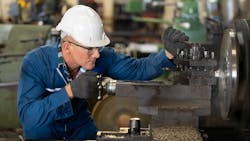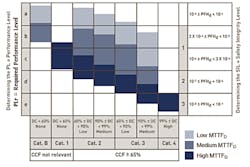READ MORE: The Competitive Value of Machine Safety
Worker safety is a top priority for manufacturers. They know that working alongside rotating parts, high-pressure fluids, and combustible fluids creates serious risks of injury. Although there are several safeguards manufacturers can add to improve machine safety, such as guards, safety locks, and management devices, a better approach is to design machines with safety as a top priority from the start. By creating established, planned approaches to preventing or reducing accidents and other unwanted events in the concept stage, jobsite injuries involving machines can be greatly reduced.
Here are 10 tips that will help engineers and specifiers in the design process to evaluate designs and ensure the safest possible working environment.
It’s important to note that even before design commences, the machine’s location must be considered; certain locations are inherently more dangerous and present added considerations when attempting to minimize the impact of failures and accidents.
READ MORE: Three Important Steps to Achieve Machine Safety
1. From the very beginning of the design process, document the process you are following. This will be compiled into a technical file and will satisfy requirements down the road if there’s an injury or discrepancy. Consult ISO 13849-1 or other relevant standards for more information and details on the process.
2. Identify all the tasks associated with the machine, as well as possible unintended uses, and consider the machine’s limits. How will it be cleaned? What is the skill level needed for people operating the machine? Consider the full spectrum of the design from installation, commissioning, operation, and maintenance to final end-of-life disposal and decommissioning.
3. Divide the machine into workable sections or zones. This is called module shaping or zoning for the purposes of evaluation. Examples include cutting zones, feeding zones, and packaging zones. By looking at individual sections, it is often easier to spot potential risks and identify workable ways to eliminate or reduce those risks.
READ MORE: How to Perform a Safety Risk Assessment for Complex Machines
4. Perform a risk assessment to determine hazards relevant to the machine. Risk assessment includes risk identification, analysis, and evaluation. Common examples are entrapment, entanglement, safe stopping distances, pinch points, and thermal devices posing burn hazards, to name a few. Remember to document the work for the technical file. Once a change is made, perform the risk assessment again to ensure no additional hazards were created by the change.
5. Perform risk reduction through design (design out risk), technical measures (safeguarding), and then instructive measures (labelling with information). Designing out risk is preferred and saves cost. However, it’s important to ensure design changes do not create other potential risks.
6. Determine the performance level required (PLr) for the safety function (see below chart). Some estimation of risk is required in this process to achieve a PLr of a, b, c, d, and e.
By determining the severity of injury, frequency of exposure to the hazard, and possibility of avoiding the hazard, a PLr for safe operation function can be determined. 7. Select the appropriate category (B, 1,2,3 or 4) and the architecture you need to achieve the desired performance level. This initial evaluation forms the PLr, or performance level required. The final outcome for the hazard must meet or exceed the PLr.
Here are the possible fault categories, according to EN 13849-1:
- Cat B: The fault can lead to loss of safety function(s)
- Cat 1: Same Cat B but losing a safety function is kle4ss likely due to a high mean time between dangerous failures (MTTFd).
- Cat 2: A fault can lead to the loss of the safety function between checks (the loss of the safety function is detected by a check).
- Cat 3: A fault in any safety related part does not cause the loss of the safety function. Whenever reasonably possible, the single fault shall be detected at or before the next demand on the safety function.
- Cat 4: Same as Category 3, but if detecting a single fault is not possible on or before the next demand on the safety function, accumulating undetected faults shall not cause the loss of the safety function.
8. Select the appropriate parts and components needed to establish the required safety level. Ensure switching times, B10 life values, MTTFd, and faulted flow rates are suitably. Consider your options. For example, could you prevent unauthorized access to parts of the machine? Or could you prevent starts before certain safety criteria have been met?
9. Calculate MTTFd using ISO 13849-1, which takes into account cycle rate and frequency of the application. Frequent cycling, for instance, can reduce MTTFd and shorten the usable life of safety devices. Further, a part with no published endurance life value (B10 life) means the onus is on the machine builder or system designer to make sure the part is tried and tested and will work as needed.
READ MORE: Designing Safety into Conveyors
10. Reassess that the design meets all requirements and validate the controls architecture using standard ISO 13849-2. Then finalize the technical file which will require the creation of user and maintenance manuals, ensuring all health and safety requirements are documented. A critical step often overlooked in machine design is validation. Simulate fault conditions (the basis of EN ISO 13849-2) and ensure the machine finds the fault and provides the proper response (stopping, blocking, holding, or shutting down). A detected fault is considered safe in the world of functional safety. Risk assessment should also be conducted by someone who did not design the equipment and can offer a fresh set of eyes.
Designing a safe machine is only the beginning. There should also be comprehensive maintenance schedules with safety-related parts of the controls tagged for end-of-life replacement for every machine. Unfortunately, this is not the case for most machinery,
Linda Caron is a certified machinery safety expert and global product manager, factory automation for Parker’s Pneumatic Div.


